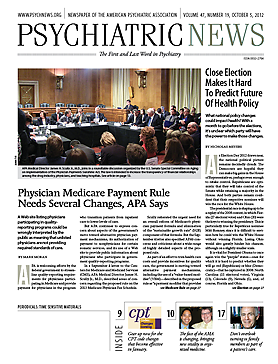Space, time, and illness are the primary influences on help-seeking behavior by veterans with posttraumatic stress disorder (PTSD).
A study in the September Psychiatric Services of 414,748 veterans who sought treatment for PTSD found three significant factors affecting how often they visited the Department of Veterans Affairs (VA) medical system for care. Data were gathered from chart reviews.
The first factor was the veteran’s place of residence.
“[S]ervice use was highly contingent on veteran proximity to care,” noted Elizabeth Brooks, Ph.D., an instructor at the Centers for American Indian and Alaska Native Health at the University of Colorado Denver, and colleagues.
Veterans from rural parts of the country paid 19 percent fewer annual visits to the VA than those from urban areas. Those from highly rural areas were even less likely (25 percent fewer visits) to go. Rates were similar with respect to use of mental health specialty clinics, as well.
“We worry that veterans living outside metropolitan communities receive less optimal care of PTSD symptomatology,” said the researchers.
In addition, veterans who had served in previous wars were more likely to use services than those who had served in more recent conflicts in Iraq or Afghanistan. The study was conducted from October 2007 through September 2008, with 53,842 of those recent vets, relatively early in those wars.
However, that difference did not apply across the board, reported Brooks and colleagues. Urban vets made an average of 8.34 annual visits, while urban members of the Iraq/Afghanistan cohort came in 6.49 times. But among rural vets, the era in which they served was not linked to their rate of service use.
Finally, veterans with a second diagnosis in addition to PTSD made 64 percent more outpatient visits to the VA system than those with PTSD alone, reported the researchers, suggesting that “patients who really needed care will seek it despite other obstacles.”
Extrapolating from their work, the authors calculated that if rural and urban veterans came at equal rates to the VA for care, they would log an additional 194,000 visits. That, in turn, would require the VA to provide many more treatment opportunities, they said.
“The VA should build on existing efforts to provide more outreach and care opportunities, including telemental health and specialized PTSD services, in rural areas and for veterans of the current service era,” Brooks concluded.
A separate study of 618 veterans by researchers at Seattle’s Puget Sound VA Health Care System found that patients who screened positive for panic disorder, alcohol misuse, or symptoms of PTSD or depression generally used inpatient or outpatient mental health services or mental health care within primary care settings.
“Although veterans largely received care in appropriate treatment settings, they may have been overutilizing the emergency room for mental health concerns and underutilizing specialty mental health services,” even when their symptoms did not demand emergency treatment, said Kristin Naragon-Gainey, Ph.D., and colleagues. “[T]his finding suggests underutilization of specialty mental health services, as do the low overall rates among those with elevated psychiatric symptoms.”
The study was funded by the U.S. Department of Veterans Affairs Rural Health Resource Center–Western Region in Salt Lake City.

